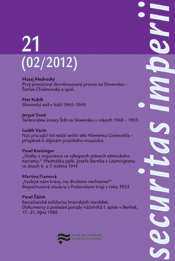Slovenský exil v Itálii 1945–1949
Slovak exiles in Italy, 1945–1949
Author(s): Petr KubíkSubject(s): WW II and following years (1940 - 1949), Migration Studies
Published by: Ústav pro studium totalitních režimů
Summary/Abstract: In summer 1945, Italy became one of the main sanctuaries of Slovaks who were connected with the wartime Slovak Republic. In post-war Italy, there was a certain duplication of power – on the one hand, authorities of the Allies and, on the other hand, Italian authorities, which did not look with favour on extraditing refugees back to their home countries. Beginning at the end of the summer of 1945, groups of Slovak refugees facing prosecution in Czechoslovakia flowed to Italy, using different ways from Bavaria and Austria. Among them was Ferdinand Ďurčanský, a Slovak politician who became the most active representative of Slovak exiles from 1945 to 1947. Karol Sidor, a former Slovak ambassador to the Holy See, still worked – albeit unofficially – in Rome, trying to help the arriving refugees. Beginning in the winter of 1945/46, Czechoslovak official authorities increased the intensity of efforts to arrest Slovak exiles, demanding, for example, the extradition of F. Ďurčanský, who had been accused of war crimes. However, these efforts for the extradition of certain Slovak refugees and activists from Italy gradually foundered due to the reluctance of Italian authorities. In the autumn of 1947, Ďurčanský’s group gradually moved away from Italy, mainly to Argentina. Karol Sidor and his colleagues stayed in Italy until 1949, but they also moved away, mainly to the USA and Canada. After that, only a small group of Slovak Catholic activists stayed in Italy, mostly priests in the Vatican. Apart from Austria and Bavaria, Italy was an important country for post-war Slovak exiles. This period is also reflected in memoirs of several significant refugees such as J. Okál, M. Šprinc, and J. Kaššovic, but no comprehensive historical study on this topic has been written yet.
Journal: Securitas imperii
- Issue Year: 2012
- Issue No: 21
- Page Range: 26-47
- Page Count: 22
- Language: Czech

